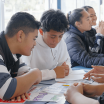Design options for sustaining effort and persistence
Engagement guideline
On this page:
On this page:
Current page section: Design options for sustaining effort
Go to top of current page: Design options for sustaining effort
Go to top of current page: Design options for sustaining effort
Go to top of current page: Design options for sustaining effort
Why this matters
Why this matters
Learners vary in how they stay motivated through challenges.
Without access to a range of flexible supports and scaffolds, some learners may get left behind (CAST, 2024).
Design options for sustaining effort and persistence prompts us to consider learner variability at the outset and offer options to:
- clarify the meaning and purpose of goals
- optimise challenge and support
- foster collaboration, interdependence, and collective learning
- foster belonging and community
- offer action-oriented feedback.
This guideline also reminds us to consider
- How will these options support learners in reaching their goals?
- Could any of these options create barriers or unnecessary challenges?
- Will all learners have fair and equal access to high-quality choices?
- How do these options reflect and respond to learner variability?
Clarify the meaning and purpose of goals
Clarify the meaning and purpose of goals
To foster effort and persistence, learners need clarity on the goal and space to explore its relevance.
Optimise challenge and support
Optimise challenge and support
Learners will vary in how they respond to challenges in learning.
Learners engage with challenges in different ways: Too little challenge is demotivating and too much challenge is overwhelming.
Consider the following:
- Presume competence and nurture a belief in the capabilities of every learner.
- Offer options with varying modes of complexity or difficulty.
- Offer options for tools and scaffolds that align with the learning goal and promote agency.
- Emphasise process, effort, and progress.
Source: Optimise challenge and support: UDL Guidelines 3.0 | CAST (2024) (opens in a new tab/window)
Foster collaboration, inter-dependence, and collective learning
Foster collaboration, inter-dependence, and collective learning
Learning with and from one another is central to the learning process.
Consider ways to foster collaboration, interdependence, and collective learning:
- Co-create community agreements that foster collaboration, interdependence, and collective learning.
- Support group work with clear shared goals, roles, expectations, and responsibilities.
- Discuss different ways to ask for help, including visual or body cues.
- Support different ways to develop ideas or generate knowledge, such as discussion, wānanga, talanoa, and digital collaboration tools.
- Encourage and support opportunities for peer interactions and supports (for example, Think-Pair-Share; peer tutors; tuakana teina).
- Support communities of learners engaged in common interests or activities or who identify in similar ways.
- Offer opportunities to learn about differing interests or activities or peers who identify in different ways.
- Encourage questioning to more fully understand concepts, ideas, and perspectives.
Foster belonging and community
Foster belonging and community
Learners differ in how much and what kinds of choices they prefer.
Discuss with learners where choices will support engagement.
Offer action-oriented feedback
Offer action-oriented feedback
Action-oriented feedback is focussed on ways to make progress and take action toward the learning goal.
Offer feedback in a way that upholds the mana of learners and:
- encourages perseverance, focuses on development of efficacy and self-awareness, and encourages the use of specific supports and strategies in the face of challenge
- emphasises effort, improvement, and achieving a goal rather than on relative performance
- is frequent, timely, and specific
- is substantive and informative rather than comparative or competitive
- models how to incorporate reflection, including identifying patterns of challenges or strengths, into positive strategies for future success
- encourages risk taking and offers another (or differing) perspective(s).
Source: Offer action-oriented feedback: UDL Guidelines | CAST (2024) (opens in a new tab/window)
Next steps
More suggestions for implementing the strategy “Design multiple means of Engagement”:
-
Current page Design options for sustaining effort
Return to the guide “Universal Design for Learning”

How to use this site
Guide to Index of the guide: Universal Design for Learning
Understand:
- Why UDL is valuable
-
Find out about UDLShow suggestions for Find out about UDL
Strategies for action:
-
Design multiple means of EngagementShow suggestions for Design multiple means of Engagement
- Design options for welcoming interests
- Design options for sustaining effort
- Design options for emotional capacity
-
Design multiple means of RepresentationShow suggestions for Design multiple means of Representation
-
Design multiple means of Action and ExpressionShow suggestions for Design multiple means of Action and Expression
-
How to plan using UDLShow suggestions for How to plan using UDL
-
Design considerations in primary settingsShow suggestions for Design considerations in primary settings
-
Design considerations in secondary settingsShow suggestions for Design considerations in secondary settings
-
Design considerations in NCEA assessmentsShow suggestions for Design considerations in NCEA assessments


